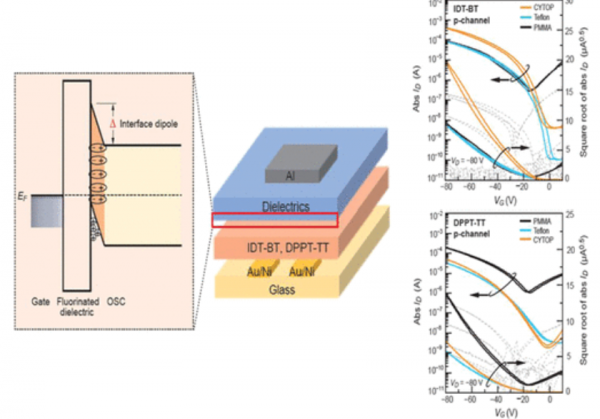Spontaneous doping at the polymer-polymer interface for high-performance organic transistors
- 저자
- Eun-Sol Shin, Won-Tae Park, Young-Wan Kwon, Yong Xu*, Yong-Young Noh*
- 저널명
- ACS Applied Materials & Interfaces, 11, 13, 12709–12716 (2019)
- 년도
- 2019
- Link
- https://doi.org/10.1021/acsami.8b21090 171회 연결
[Abstract]
Low-k amorphous fluorinated polymers such as poly(perfluoroalkenylvinyl ether) (CYTOP) have widely been used as gate dielectrics for organic field-effect transistors (OFETs) because of their strong hydrophobicity to prevent the penetration of moisture and other contaminants and their perfect solvent orthogonality with organic semiconductors. Here, we report a new functionality of the fluorinated low-k polymer dielectrics, which is spontaneous p doping at the dielectric–semiconductor interface in OFETs. This functionality makes the ambipolar charge transport a unipolar p type. In the OFETs based on indacenodithiophene-co-benzothiadiazole and diketopyrrolopyrrole-thieno[3,2-b]thiophene, the charge transport is obviously ambipolar when paired with common polymer dielectrics such as poly(methyl methacrylate); however, it is perfectly modulated to the unipolar p type by applying the fluorinated dielectrics of CYTOP and poly(tetrafluoroethylene) (Teflon). We propose that this modulation of charge transport results from the rearrangement of C–F bonds at the interface between the fluorine-containing dielectrics and the conjugated polymer semiconductors by proper thermal annealing. These well-aligned dipole moments lead to an abrupt downshift of the Fermi level of the semiconductor toward the highest occupied molecular orbitals near the dielectric–semiconductor interface, which provides a p-doping effect on the channel transport and results in unipolar p-type characteristics in the composed OFETs. This study reveals a new functionality of the fluorinated dielectrics for future organic electronics.
